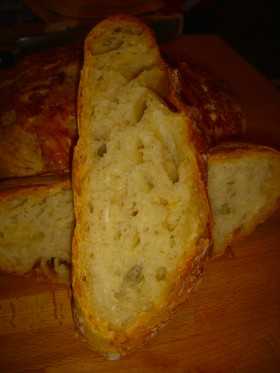You wouldn’t want to use anything but the freshest ingredients for your pizza creations. The same goes for bread.
Flour
Fresh flour, except for whole wheat and rye, should have little to no odor. If it does, it’s gone rancid. Wheat and rye flours are best purchased in small amounts because they do not last as long as bread or all-purpose flours. Bleached flours of any kind are not recommended here; they will give you a white bread, but much less taste. If possible, store flours in sealed, air-tight containers, in a dark, cool spot.
It’s odd that the flours found on supermarket shelves ordinarily do not show a “best before” date. This might mean that one bag of flour is a month old, another a year old. Try to purchase your flours from dealers with a high turnover rate, or patronize a specialty grain supplier. Organic flours, by their very nature, are best used quickly. There are many very good flours available, although for bread the single most reliable brand in the United States is King Arthur. Avoid ’best for bread’ formulations from other mills. Unless otherwise specified, you want to use hard, unbleached bread flour (preferably stone ground) for the recipes given here.
Yeast
Commercial yeasts, either instant dry (IDY) or active dry (ADY), also have a finite shelf life. Here, SAF Gold instant yeast is recommended, because of its dependability and performance. Fleischman’s Active Dry Yeast is quite good for most applications that call for this type. Do yourself a favor and buy your yeasts in the larger, vacuum sealed bags, because the price of yeast in smaller foil packets or glass jars is exorbitant. Once opened, transfer the yeasts to airtight containers and store in the freezer. Without using a conversion chart, IDY and ADY are not interchangeable in any of the following recipes.
Water
Yeast, either commercial or wild, does not like chlorine, but seems to favor minerals, so don’t use chlorinated tap water! Your water should be bottled (no salt added) or filtered to remove chlorine, but mineral-rich spring water is probably best if you have a source. Distilled water does not work as well as these three. Getting your water up to proper temperature is best done in a microwave. Usually, the water temperature should be between 90 and 100ºF in order to activate the commercial yeast. If you’re using a wild yeast starter (called a sourdough in North America, a levain in France), water temperature is normally much cooler, in the 70°F range. Managing the temperature of all your ingredients is one of the most important and most often overlooked keys to consistently successful bread.
Salt
Bread dough is made from just four fundamental ingredients: flour, water, yeast in some form or another, and salt. Table or iodized salt might be fine on broccoli, but the flavor of good sea salt cannot be beaten for bread. There are many, many types of sea salt available, but the gray, sun-dried sea salt from the Brittany coast of France imparts the best flavor.
These are a few basics. The next section will introduce you to the specifics of making sensational bread in your brick oven, including The Gear.
Back Forward





